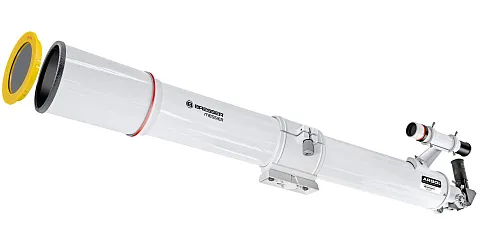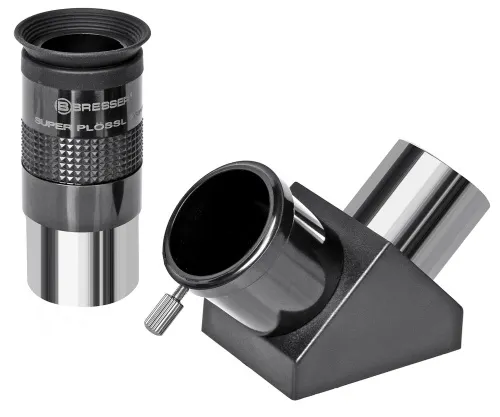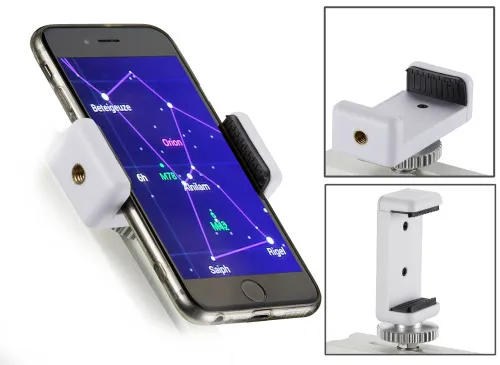Bresser Messier AR-90L/1200 OTA
Aperture: 90mm. Focal length: 1200mm
| Product ID | 74265 |
| Brand | Bresser GmbH, Germany |
| Warranty | 2 years |
| EAN | 4007922039190 |
| Package size (LxWxH) | 128x31x26 cm |
| Shipping Weight | 14.4 kg |
New – now including a high-quality aperture solar-filter for safe observation of sunspots, eclipses and planet transits. Great telescope for night and solar observation.
Excellent for entering into the hobby of astronomy: 90mm aperture delivers 200 times more light than the naked eye! Observe craters, valleys and rims on the moon from nearly 400000km away just as you would look out of the window of a spaceship!
The Messier AR-90L does not only provide highly detailed views of the moon: gaze at the division of the rings of Saturn millions of kilometers away or explore the Great Red Spot of Jupiter, a giant tornado in Jupiter's atmosphere. Watch the seasons on Mars and find the sickle of Venus.
The Messier AR-90L gives you images that are many times brighter than the instrument Galileo Galilei was using for his famous explorations almost 400 years ago.
This telescope is an optical tube without mount and tripod.
Key features:
- Optical design: refractor telescope
- Lens diameter: 90mm; focal length: 1200mm, f/13,3
- Maximum recommended magnification: 180x
- Telescope for night and solar observation
- High quality Bresser refractor optics
- Ideal telescope for planets, double stars and planetary nebulae
- 31.7mm (1.25") diagonal mirror
- 6x30 straight through viewfinder reticle
- Optimized finder socket for comfortable use
- Cradle ring with piggyback camera holder (1/4 thread)
- Smartphone camera adapter for sky navigation included
- Universal 44mm dovetail adapter (fits LXD75/Great Polaris/EQ5)
- Rack and pinion focuser 31.7mm/1.25"
The kit includes:
- 90mm refractor telescope tube assembly
- Aperture solar-filter
- 26mm Super Plössl eyepiece 31.7mm (1.25")
- Diagonal mirror 3.7mm (1.25")
- Tube clamps with universal 44mm dovetail plate (fits LXD75/Great Polaris/EQ5)
- Smartphone adapter for celestial navigation
- 6x30 optical finder
- Astronomy software Stellarium
- Rotatable star map
| Product ID | 74265 |
| Brand | Bresser GmbH, Germany |
| Warranty | 2 years |
| EAN | 4007922039190 |
| Package size (LxWxH) | 128x31x26 cm |
| Shipping Weight | 14.4 kg |
| Optical design | refractor |
| Optical scheme | achromat |
| Optics coating | multi-coated |
| Objective lens diameter (aperture), mm | 90 |
| Focal length, mm | 1200 |
| Magnification, x | 30 — 180 |
| Aperture ratio | f/13.3 |
| Finderscope | 6х30 |
| Focuser | 1.25", rack & pinion |
| Solar filter included | ✓ |
| Optical tube material | aluminum |
| User level | beginners, experienced users |
| Observed object | planets of the Solar System, the Sun |
Convenient diagrams that describe how to install additional accessories on refractors and catadioptric telescopes
Find out how to assemble a telescope on an example of the Levenhuk Skyline 90x900 EQ telescope
This short guide will help you avoid typical mistakes and learn more about telescope and mounting types
The basics of astronomical observations for beginners
In this article we have gathered answers to some of the most frequently asked questions about telescopes
How telescopes work?
You can actually perform observations from your balcony!
All about telescope sizes, types, magnification, and mounts
Learn how to set up and use the telescope properly
Astronomy in light-polluted skies. Find out what you can observe in the city
Read an interesting comprehensive article on telescopes for little astronomers
Celestial objects you can observe with telescopes of different apertures
Colored and vivid images of galaxies, planets and star clusters entrance everyone who is fascinated by boundless space
Find an interesting review on the history of the changes to a refracting telescope
To make the process of choosing a telescope easier, we will tell you about the characteristics of the most popular types of telescopes today
Learn everything you need to know about refractor telescopes to make the right choice












